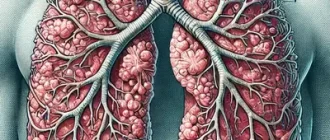Pierre Robin Syndrome (PRS) is a rare congenital condition characterized by a triad of features: a small lower jaw (micrognathia), a tongue that is placed further back in the mouth (glossoptosis), and airway obstruction. Some infants may also have a cleft palate, which complicates feeding and speech development.
This syndrome occurs in approximately 1 in 8,500 to 14,000 live births, though exact prevalence varies by population. PRS can occur as an isolated condition or as part of a broader syndrome, such as Stickler syndrome.
Prevalence by Genetic vs. Environmental Factors
| Cause | Percentage |
|---|---|
| Genetic Factors | 60% |
| Environmental/Unknown | 40% |
This chart highlights the prevalence of genetic versus environmental or unknown factors in Pierre Robin Syndrome cases, with genetic causes accounting for the majority.
What Causes Pierre Robin Syndrome?
The exact cause of PRS remains unclear, but it is often linked to developmental disruptions during early fetal growth. Factors include:
- Genetic mutations: In syndromic cases, mutations in genes such as COL11A1 or COL2A1 (associated with Stickler syndrome) are implicated.
- Mechanical factors: Crowding in the uterus or other environmental factors during pregnancy may restrict jaw growth.
- Unknown origins: A significant number of cases occur sporadically without a clear genetic or environmental link.
Did you know? Stickler syndrome accounts for 35-50% of syndromic PRS cases and is a major cause of vision and hearing impairments in affected children.
Signs and Symptoms
Children with PRS exhibit symptoms that vary in severity:
- Respiratory difficulties: Due to glossoptosis, infants may experience significant airway obstruction, particularly when lying on their back.
- Feeding issues: A cleft palate can interfere with sucking and swallowing, leading to poor weight gain.
- Facial abnormalities: A visibly small lower jaw and recessed chin are hallmark features.
- Associated conditions: Hearing loss, vision problems, and developmental delays may occur in syndromic cases.
Complications to Watch For
- Sleep apnea: Obstructive sleep apnea is common in PRS infants.
- Choking risk: Airway obstruction increases the risk of choking during feeding.
- Otitis media: Frequent ear infections due to fluid buildup in the middle ear.
Diagnosis: How is PRS Identified?
Diagnosis often occurs shortly after birth, based on clinical examination. Key diagnostic tools include:
- Physical examination: Identifying micrognathia and glossoptosis.
- Imaging tests: X-rays or MRIs to assess airway obstruction and jaw alignment.
- Genetic testing: Essential to identify syndromic PRS and associated genetic mutations.
Early diagnosis is critical for managing complications effectively.
Treatment Options
The treatment of PRS is highly individualized, focusing on alleviating symptoms and ensuring proper growth and development.
1. Airway Management
- Positioning: Placing infants in a prone position can help reduce airway obstruction.
- Nasopharyngeal tubes: Temporary tubes can bypass obstructions.
- Surgical options: Procedures like mandibular distraction osteogenesis may be necessary to lengthen the jaw.
2. Feeding Assistance
- Special feeding bottles: Designed for babies with cleft palates.
- Gastrostomy tubes: For severe cases where oral feeding is not possible.
3. Surgical Interventions
- Cleft palate repair: Typically performed around 12-18 months of age.
- Tongue-lip adhesion: Occasionally used to secure the tongue in a forward position.
4. Long-Term Support
- Speech therapy: For addressing speech delays caused by cleft palate.
- Hearing aids: When hearing loss is present.
- Orthodontic care: To manage dental complications as the child grows.
Surgical Outcomes Over Time
| Year | Success Rate |
|---|---|
| 2010 | 70% |
| 2015 | 80% |
| 2020 | 90% |
This chart illustrates the improvement in surgical success rates for Pierre Robin Syndrome from 2010 to 2020, reflecting advances in medical techniques.
Prognosis and Quality of Life
While PRS poses significant challenges in infancy, the prognosis is generally favorable with appropriate medical and surgical interventions. Most children achieve normal growth and development, though some may require ongoing care for related conditions like hearing loss or speech delays.
A Closer Look: Pierre Robin Syndrome in Practice
A 2-week-old infant presented with severe feeding difficulties and frequent cyanotic episodes. Examination revealed classic signs of PRS, including micrognathia and airway obstruction. After immediate airway stabilization using a nasopharyngeal tube, the infant was referred for genetic testing, confirming Stickler syndrome. Long-term management included cleft palate repair at 15 months and continued monitoring for vision and hearing impairments.
Feeding Techniques Effectiveness
| Feeding Method | Effectiveness (Weight Gain) |
|---|---|
| Special Feeding Bottles | 70% |
| Gastrostomy Tubes | 90% |
| Traditional Methods | 50% |
This chart compares the effectiveness of different feeding techniques for infants with Pierre Robin Syndrome, measured by weight gain improvement.
Editorial Advice
Early intervention and a multidisciplinary approach are vital for managing Pierre Robin Syndrome effectively. Parents and caregivers should seek specialized care teams, including pediatricians, geneticists, and surgeons, to address both immediate needs and long-term challenges. With timely treatment, most children can lead healthy, fulfilling lives.
description:
Comprehensive guide to Pierre Robin Syndrome: symptoms, causes, treatments, and long-term care options for affected children.
About the Author
Reyus Mammadli is the author of this health blog since 2008. With a background in medical and biotechnical devices, he has over 15 years of experience working with medical literature and expert guidelines from WHO, CDC, Mayo Clinic, and others. His goal is to present clear, accurate health information for everyday readers — not as a substitute for medical advice.







